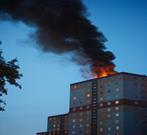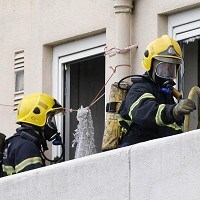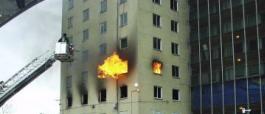Three line intervention should be regarded as the default deployment for a fire whose size and development can not be fully and accurately ascertained.
If 45mm hose and conventional automatic branches are used optimal flow rates will be very difficult to achieve.
For optimum flow rates in these scenarios combinations of 51mm hose and specially designed "low pressure -high flow" or smooth bore branches should be considered.
BUT It must be remembered that having 3 working jets on the upper stories of buildings taller than 10 stories (30M), there is a serious risk of overrunning the supply acheivable from a 10 Bar 4" (100mm) Dry riser. (See Dry rise supply rates)
Deployment of three line tactics
A PROPOSED FORMAT FOR A 3 Line (Crew of 14)
Whenever possible the Medium risk zone should be immediately evacuated by the reconnaissance team. The actions of opening the compartment will undoubtedly cause smoke logging in any adjouning corridor. These areas will become a High Risk zone.
Although occupants in unaffected flats in the Medium risk zone should be protected by the compartmentation of the building, this may be difficult to rely on without solid pre-incident intelligence. Also,during the intervention, the occupants may panic and attempt to self evacuate.
Deployment
The reconnaissance team (2 Ff and 1 supervisor) set into the dry riser outlet on incident floor if possible and lay out one line of hose.
An additional 2 Ff with BA and 1 Entry Control Officer (ECO) liaise with the reconnaissance team supervisor. On arrival of the second BA team and ECO, the second line of hose is connected to the riser outlet and laid out.
A third hose line is laid from a floor between the bridgehead and the fire floor. This line MUST be capable of reaching all areas of the fire floor and flats connected to it.
The Supervisor, either IC or Sector commander (Bridgehead) conducts a risk assessment and confirms, by using internal and external and internal observer, that compartment entry is viable.
Entry may only be made to flat where it deamed viable, benificial and is fully assesed using an informed DRA. If any doubt regarding the safety of personnel undertaking such actions exists, intervention should reconcidered and other tactical options reviewed (containment etc..)
The three BA teams then start up their BA sets in clean air outside the Medium risk zone (usually at the bridgehead) or, where compartmentation is absent within a smoke free corridor or a location risk assessed as safe for this purpose.
The BA teams initiate the compartment entry as follows;
1. BA team to provide safety cover , protecting and monitoring the means of egress.
2. BA team positioned at (or close to) entrance to the compartment with a covering/backup jet.
3. BA team enter the compartment with a fire fighting jet.
The BA board is then taken by the ECO to establish the ECP at the bridgehead (the location of which is clearly identified to the BA wearers prior to their committal to allow accurate wear planning).
All further BA teams will be committed from the bridgehead through this ECP.
All high rise BA operations should consider the fact that the BA ECP may have to be moved or relocated if there is uncontroled smoke travel.
The bridgehead is commanded by a Sector Commander (Bridgehead)
Overall Incident Operational Command is always with the IC
It is normally a requirement to evacuate the Medium risk zone (ie any adjoining corridor or hall that may become involved) prior to undertaking any intervention.
The IC’s risk assessment will have considered the likelihood of fire spread beyond the affected compartments fire resistance measures (based on the signs and symptoms of fire identified by the reconnaissance team and any external observation) prior to implementing this tactic.
SET ALLOCATION OF INITIAL TASKS
The following set tasks should be nominated, in order, to the first 14 relevant personnel attending as part of the initial attendance.
1 X ICS L1 = IC
1 X ICS L1 = SC (Bridgehead)
1 x Ff = Pump operator
2 x Ff = BA wearers (reconnaissance and Intervention team)
2 x Ff = BA wearers (covering/backup jet)
2 x Ff = BA wearers (Safety team)
1 X Ff = ECO
2 x Ff = BA Emergency crew (at Bridgehead)
1 x Ff = External Observer
1 x Ff = Command support
 This link will take you away from www.highrisefire.co.uk Please be aware that we do not necessarily endorse or support the views, opinions and expressions of this site !
This link will take you away from www.highrisefire.co.uk Please be aware that we do not necessarily endorse or support the views, opinions and expressions of this site !



